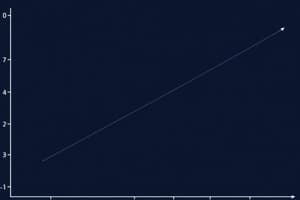Podcast
Questions and Answers
Which of the following represents a measure of how quickly an algorithm runs?
Which of the following represents a measure of how quickly an algorithm runs?
- Time complexity (correct)
- Space complexity
- Algorithm efficiency
- Auxiliary complexity
What is the notation used to describe both time and space complexity of algorithms?
What is the notation used to describe both time and space complexity of algorithms?
- Sigma notation
- Theta notation
- Big O notation (correct)
- Omega notation
Which time complexity denotes an algorithm that uses auxiliary memory proportional to the input size?
Which time complexity denotes an algorithm that uses auxiliary memory proportional to the input size?
- O(1)
- O(log(n))
- O(n²)
- O(n) (correct)
Which of the following time complexities is the slowest?
Which of the following time complexities is the slowest?
Which scenario would most likely result in a time complexity of O(n + m)?
Which scenario would most likely result in a time complexity of O(n + m)?
Flashcards
Time Complexity
Time Complexity
A measure of how quickly an algorithm runs based on input size.
Space Complexity
Space Complexity
A way to describe how much additional memory an algorithm uses, also based on input size.
Big O Notation
Big O Notation
A notation used to express the rate of growth of an algorithm's time or space usage as the input size increases.
Constant Time Complexity (O(1))
Constant Time Complexity (O(1))
Signup and view all the flashcards
Linear Time Complexity (O(n))
Linear Time Complexity (O(n))
Signup and view all the flashcards
Study Notes
Time Complexity
- A measure of how quickly an algorithm runs.
- Central concept in algorithms and coding interviews.
- Expressed using Big O notation.
Space Complexity
- A measure of how much auxiliary memory an algorithm uses.
- Central concept in algorithms and coding interviews.
- Expressed using Big O notation.
Big O Notation
- Notation used to describe time and space complexity of algorithms.
- Variables in Big O notation represent input sizes.
- Example: O(n) represents the time complexity of an algorithm traversing an array of length n.
- O(n + m) represents the time complexity of an algorithm traversing an array of length n and a string of length m.
Common Time Complexities (Fastest to Slowest)
- Constant: O(1)
- Logarithmic: O(log n)
- Linear: O(n)
- Log-linear: O(n log n)
- Quadratic: O(n2)
- Cubic: O(n3)
- Exponential: O(2n)
- Factorial: O(n!)
Studying That Suits You
Use AI to generate personalized quizzes and flashcards to suit your learning preferences.




